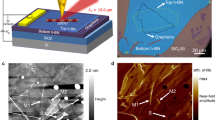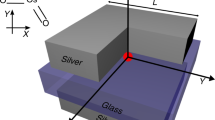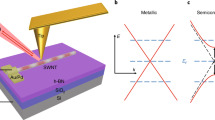Abstract
Optical transitions between electronic levels are restricted according to the selection rules governed by the parities of electronic wavefunctions1. If this restriction can be removed, then drastic improvements in the efficiency and diversity of photoreactions may be realized. Because the selection rules are based on the long wavelength approximation, wherein the field amplitude is assumed to be constant within a molecule, a localized plasmon that has an electromagnetic field with a significantly high gradient is expected to violate the conventional limitations of the optical response2. Here, we demonstrate the possibility of controlling the optical electronic transitions of a single-walled carbon nanotube (SWNT) using metal nanodimers with a controlled nanogap distance. Highly systematic identification of the excitations of individual SWNTs through well-resolved Raman signals implies a breakdown of the selection rules due to the strong field gradient in the radial direction of the SWNTs.
This is a preview of subscription content, access via your institution
Access options
Subscribe to this journal
Receive 12 print issues and online access
$209.00 per year
only $17.42 per issue
Buy this article
- Purchase on Springer Link
- Instant access to full article PDF
Prices may be subject to local taxes which are calculated during checkout





Similar content being viewed by others
References
Turro, N. J., Ramamurthy, V. & Scaiano, J. C. in Modern Molecular Photochemistry of Organic Molecules Ch. 3, 109–167 (University Science Books, 2010).
Burstein, E., Lundqvist, S. & Mills, D. L. in Surface Enhanced Raman Scattering (eds Chang, R. K. & Furtak, T. E.) 67–89 (Plenum, 1982).
Ru, L. E. C. & Etchegoin, P. G. Principles of Surface-Enhanced Raman Spectroscopy and Related Plasmonic Effects (Elsevier Science, 2008).
Kedziora, G. S. & Schatz, G. C. Calculating dipole and quadrupole polarizabilities relevant to surface enhanced Raman spectroscopy. Spectrochim. Acta A 55, 625–638 (1999).
Ayars, E. J., Hallen, H. D. & Jahncke C. L. Electric field gradient effects in Raman spectroscopy. Phys. Rev. Lett. 85, 4180–4183 (2000).
Kneipp, K. et al. Polarization effects in surface-enhanced resonant Raman scattering of single-wall carbon nanotubes on colloidal silver clusters. Phys. Rev. B 63, 081401 (2001).
Polubotko, A. M. Some anomalies of the SER spectra of symmetrical molecules adsorbed on transition metal substrates: consideration by the dipole–quadrupole SERS theory. J. Raman Spectrosc. 36, 522–532 (2005).
Iida, T. & Ishihara, H. Unconventional control of excited states of a dimer molecule by a localized light field between metal nanostructures. Phys. Status Solidi (a) 206, 980–984 (2009).
Iida, T., Aiba, Y. & Ishihara, H. Anomalous optical selection rule of an organic molecule controlled by extremely localized light field. Appl. Phys. Lett. 98, 053108 (2011).
Jain, P., Ghosh, D., Baer, R., Rabani, E. & Paul, A. Near-field manipulation of spectroscopic selection rules on the nanoscale. Proc. Natl Acad. Sci. USA 109, 8016–8019 (2012).
Research Highlights, Nanophotonics: Rewriting selection rules. Nature Nanotech. http://dx.doi.org/10.1038/nnano.2012.104 (2012).
Mahmoud, M. A., Chamanzar, M., Adibi, A. & El-Sayed, M. A. Effect of the dielectric constant of the surrounding medium and the substrate on the surface plasmon resonance spectrum and sensitivity factors of highly symmetric systems: silver nanocubes. J. Am. Chem. Soc. 134, 6434–6442 (2012).
Ajiki, H. & Ando, T. Electronic states of carbon nanotubes. J. Phys. Soc. Jpn 62, 1255–1266 (1993).
Ajiki, H. & Ando, T. Aharonov–Bohm effect in carbon nanotubes. Physica B 201, 349–352 (1994).
Uryu, S. & Ando, T. Exciton absorption of perpendicularly polarized light in carbon nanotubes. Phys. Rev. B 74, 155411 (2006).
Duesberg, G. S., Loa, I., Burghard, M., Syassen, K. & Roth, S. Polarized Raman spectroscopy on isolated single-wall carbon nanotubes. Phys. Rev. Lett. 85, 5436–5439 (2000).
Jorio, A. et al. Resonance Raman spectra of carbon nanotubes by cross-polarized light. Phys. Rev. Lett. 90, 107403 (2003).
Hartschuh, A., Sanchez, E. J., Xie, X. S. & Novotny L. High-resolution near-field Raman microscopy of single-walled carbon nanotubes. Phys. Rev. Lett. 90, 095503 (2003).
Hayazawa, N., Yano, T., Watanabe, H., Inouye, Y. & Kawata S. Detection of an individual single-wall carbon nanotube by tip-enhanced near-field Raman spectroscopy. Chem. Phys. Lett. 376, 174–180 (2003).
Kataura, H. et al. Optical properties of single-wall carbon nanotubes. Synth. Met. 103, 2555–2558 (1999).
Araujo, P. T. et al. Third and fourth optical transitions in semiconducting carbon nanotubes. Phys. Rev. Lett. 98, 067401 (2007).
Miyauchi, Y., Ajiki, H. & Maruyama, S. Electron–hole asymmetry in single-walled carbon nanotubes probed by direct observation of transverse quasidark excitons. Phys. Rev. B 81, 121415 (2010).
Miyauchi, Y., Oba, M. & Maruyama, S. Cross-polarized optical absorption of single-walled nanotubes by polarized photoluminescence excitation spectroscopy. Phys. Rev. B 74, 205440 (2006).
Nguyen, K., Gaur, A. & Shim, M. Fano lineshape and phonon softening in single isolated metallic carbon nanotubes. Phys. Rev. Lett. 98, 145504 (2007).
Nagasawa, F., Takase, M., Nabika, H. & Murakoshi, K. Polarization characteristics of surface-enhanced Raman scattering from a small number of molecules at the gap of a metal nano-dimer. Chem. Commun. 47, 4514–4516 (2011).
Sawai, Y., Takimoto, B., Nabika, H., Ajito, K. & Murakoshi, K. Observation of a small number of molecules at a metal nanogap arrayed on a solid surface using surface-enhanced Raman scattering. J. Am. Chem. Soc. 129, 1658–1662 (2007).
Purcell, E. M. & Pennypacker, C. R. Scattering and absorption of light by non-spherical dielectric grains. Astrophys. J. 186, 705–714 (1973).
Lu, J. Y. & Chang, Y. H. Implementation of an efficient dielectric function into the finite difference time domain method for simulating the coupling between localized surface plasmons of nanostructures. Superlatt. Microstruct. 47, 60–65 (2010).
Ando, T. Excitons in carbon nanotubes. J. Phys. Soc. Jpn 66, 1066–1073 (1997).
Heller W. R. & Marcus, A. A note on the propagation of excitation in an idealized crystal. Phys. Rev. 84, 809–813 (1951).
Ajiki, H. Exciton wave functions with electron–hole exchange interaction: application to carbon nanotubes. J. Phys. Soc. Jpn 82, 054701 (2013).
Acknowledgements
The authors thank R. Saito (Tohoku University) for helpful discussions on Raman spectral analysis. This work was partially supported by Grants-in-Aid for scientific research from the Ministry of Education, Science and Culture, Japan. Support from the Priority Area ‘Strong Photon–Molecule Coupling Fields (no. 470)’ is particularly acknowledged.
Author information
Authors and Affiliations
Contributions
M.T., H.A., Y.M., K.K., M.N., H.N., S.Y., H.I. and K.M. performed experiments and data analysis. H.A. carried out calculations on the electronic structure of SWNTs. Y.M. and H.I. developed the EDDA and performed calculations with this method. M.T., H.A., Y.M., S.Y., H.I. and K.M. contributed to writing the paper.
Corresponding authors
Ethics declarations
Competing interests
The authors declare no competing financial interests.
Supplementary information
Supplementary information
Supplementary information (PDF 830 kb)
Rights and permissions
About this article
Cite this article
Takase, M., Ajiki, H., Mizumoto, Y. et al. Selection-rule breakdown in plasmon-induced electronic excitation of an isolated single-walled carbon nanotube. Nature Photon 7, 550–554 (2013). https://doi.org/10.1038/nphoton.2013.129
Received:
Accepted:
Published:
Issue Date:
DOI: https://doi.org/10.1038/nphoton.2013.129
This article is cited by
-
Nanostructure-assisted optical tweezers for microspectroscopic polymer analysis
Polymer Journal (2021)
-
Optical force mapping at the single-nanometre scale
Nature Communications (2021)
-
Combining density functional theory with macroscopic QED for quantum light-matter interactions in 2D materials
Nature Communications (2021)
-
Breakdown of Raman selection rules by Fröhlich interaction in few-layer WS2
Nano Research (2021)
-
Fundamental understanding and applications of plasmon-enhanced Raman spectroscopy
Nature Reviews Physics (2020)



